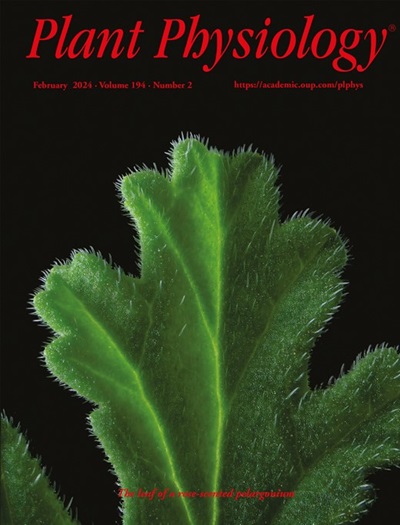The Ca2+ channels CNGC2 and CNGC20 mediate methyl jasmonate-induced calcium signaling and cold tolerance
IF 6.9
1区 生物学
Q1 PLANT SCIENCES
引用次数: 0
Abstract
The phytohormone methyl jasmonate (MeJA) enhances plant cold stress tolerance, but the underlying mechanisms remain elusive. Here, we discovered that MeJA induces a transient Ca2+ influx and elevated cytoplasmic free Ca2+ ([Ca2+]cyt) levels during the watermelon (Citrullus lanatus) response to cold stress. Conversely, silencing jasmonic acid carboxyl methyltransferase (ClJMT), encoding an enzyme that methylates JA to MeJA, led to contrasting effects compared to MeJA application. Upon cold exposure, MeJA rapidly and continuously upregulated two Ca2+-permeable channel genes, namely cyclic nucleotide-gated ion channel (ClCNGC) 2 and ClCNGC20. Silencing ClCNGC2 or ClCNGC20 attenuated MeJA-induced Ca2+ influx, [Ca2+]cyt accumulation, C-REPEAT BINDING FACTOR (CBF) pathway activation, and watermelon cold tolerance. Accordingly, ClCNGC2 or ClCNGC20 overexpression increased Ca2+ influx, [Ca2+]cyt levels, and expression of the CBF regulon, and improved freezing tolerance in transgenic Arabidopsis thaliana plants. Multiple assays showed that ClCNGC2 and ClCNGC20 do not directly interact. Interestingly, silencing ClCNGC2 or ClCNGC20 abolished MeJA-induced upregulation of ClCNGC20 or ClCNGC2, respectively, in watermelon response to cold, demonstrating their reciprocal activation at the transcriptional level. Collectively, these findings suggest a mutual dependence between ClCNGC2 and ClCNGC20 in mediating MeJA-induced Ca2+ influx followed by [Ca2+]cyt elevation, subsequently activating the CBF pathway and enhancing cold tolerance in plants. This study provides insights into the molecular mechanisms underlying MeJA-mediated plant cold tolerance, holding potential for the breeding or engineering of cold-resistant cucurbit varieties.Ca2+通道CNGC2和CNGC20介导茉莉酸甲酯诱导的钙信号和耐寒性
植物激素茉莉酸甲酯(MeJA)增强植物的冷胁迫耐受性,但其机制尚不清楚。在这里,我们发现在西瓜(Citrullus lanatus)对冷胁迫的反应过程中,MeJA诱导了短暂的Ca2+内流和细胞质游离Ca2+ ([Ca2+]cyt)水平的升高。相反,茉莉酸羧基甲基转移酶(ClJMT)编码一种将JA甲基化为MeJA的酶,沉默茉莉酸羧基甲基转移酶(ClJMT)与MeJA的应用产生了截然不同的效果。冷暴露后,MeJA快速且持续上调两个Ca2+可渗透通道基因,即环核苷酸门控离子通道(ClCNGC) 2和ClCNGC20。沉默ClCNGC2或ClCNGC20可减弱meja诱导的Ca2+内流、[Ca2+]细胞积累、C-REPEAT结合因子(CBF)途径激活和西瓜耐寒性。因此,ClCNGC2或ClCNGC20过表达增加了转基因拟南芥植株的Ca2+内流、[Ca2+]cyt水平和CBF调控因子的表达,并提高了其抗冻性。多项实验表明,ClCNGC2和ClCNGC20不直接相互作用。有趣的是,沉默ClCNGC2或ClCNGC20可以消除meja诱导的ClCNGC20或ClCNGC2在西瓜对寒冷的反应中的上调,表明它们在转录水平上相互激活。总的来说,这些发现表明ClCNGC2和ClCNGC20在介导meja诱导的Ca2+内流和[Ca2+]cyt升高,随后激活CBF途径并增强植物的耐寒性方面相互依赖。该研究为meja介导的植物耐冷性的分子机制提供了深入的见解,为耐寒葫芦品种的育种或工程设计提供了潜力。
本文章由计算机程序翻译,如有差异,请以英文原文为准。
求助全文
约1分钟内获得全文
求助全文
来源期刊

Plant Physiology
生物-植物科学
CiteScore
12.20
自引率
5.40%
发文量
535
审稿时长
2.3 months
期刊介绍:
Plant Physiology® is a distinguished and highly respected journal with a rich history dating back to its establishment in 1926. It stands as a leading international publication in the field of plant biology, covering a comprehensive range of topics from the molecular and structural aspects of plant life to systems biology and ecophysiology. Recognized as the most highly cited journal in plant sciences, Plant Physiology® is a testament to its commitment to excellence and the dissemination of groundbreaking research.
As the official publication of the American Society of Plant Biologists, Plant Physiology® upholds rigorous peer-review standards, ensuring that the scientific community receives the highest quality research. The journal releases 12 issues annually, providing a steady stream of new findings and insights to its readership.
 求助内容:
求助内容: 应助结果提醒方式:
应助结果提醒方式:


